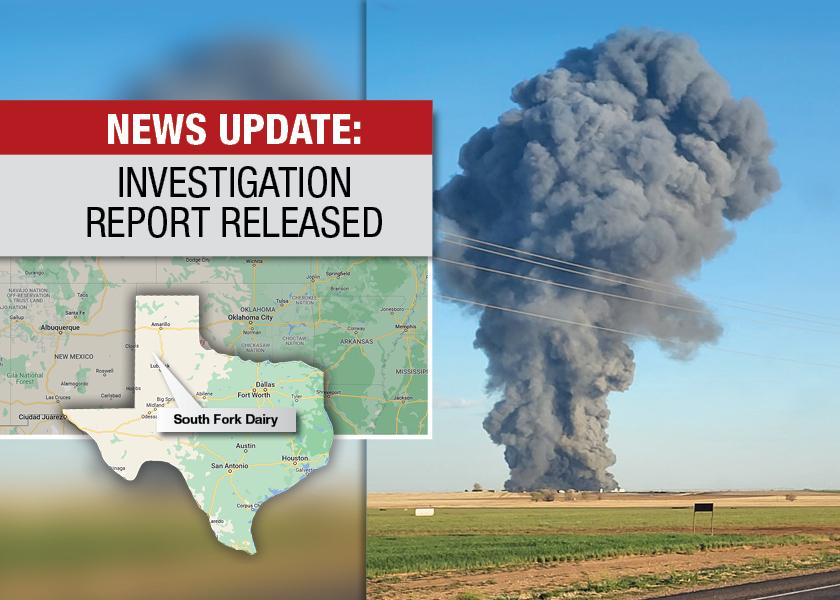Accidental and No Foul Play, Investigation Reveals Cause of Explosion, Massive Fire at Texas Dairy

It’s been two weeks since a massive fire broke out at a Texas dairy killing more than 17,000 cows. The Texas State Fire Marshal’s Office released a report from its investigation, ruling the fire as accidental with no reported evidence of foul play.
The explosion and fire occurred at South Fork Dairy, which is located just southeast of Dimmitt, on the evening of Monday, April 10, 2023. According to a new release from the Texas State Fire Marshal’s Office, the investigation found the fire originated in the northern end of the dairy, and was the result of a “failure of a piece of equipment that is used within the dairy on a daily basis.”
The release also stated, “Because of the size of the fire, the insured loss amount, the number of cattle killed, and the fact that two other pieces of equipment, identical to the one that caught fire, have burned previously. One at this dairy and one at another dairy. There will be a more in-depth investigation of the reason for the failure by other origin and cause investigators and engineers that are experts in the field of equipment failures.”
Read More: What We Now Know About What Caused the Large Fire at a Texas Dairy Farm
Officials also said the explosion was the result of flammable liquids, including liquid fuel, hydraulic oil and other materials, “expanding rapidly,” causing a “smoke explosion.”
The State Fire Marshal’s report aligns with what was reported on AgWeb the same week as the fire broke out. The local sheriff speculated a "honey badger” - a machine which he described as a "vacuum that sucks the manure and water out” - may have been the cause. However, as Farm Journal first reported, it seems the sheriff misspoke, as there’s no piece of equipment called a “honey badger” in dairy. Instead, it’s called a “honey vac.”
The sheriff also stated his initial assessment was the insulation catching fire is what caused the fire to spread.
Based on the current information from officials, and aerial video that shows a charred roof evenly across the barn, Farm Journal reached out to several dairy producers that week, as well as insurance experts, to see if the honey vac and insulation would cause such a large fire.
One source told Farm Journal the manure vacuum that sucks manure from cow lanes could have ignited the fire, as he’s had it happen before on their dairy farm. In their case, the fire didn’t spread.
Additional sources said if the explosion was big enough to catch any part of non-fire-resistant insulation on fire, then it would spread like wildfire across the entire building, which covers nearly 40 acres. That would also explain why the fire didn’t last long, because once the insulation was all burned, then the fuel to the fire would also be gone. Insulation not being fireproof would also explain why the building had so much black smoke.
So, then what would cause the large mushroom cloud of black smoke? The building that caught fire was a recently built cross-ventilated barn. Cross-ventilated barns are typically large and have hundreds of fans to help control the climate with cow comfort in mind. With that many fans in a barn, it's possible once the fire spread so quickly, the hundreds of fans within the barn blew out the smoke, creating such a big smoke cloud that could be seen from miles away.
Official Investigation Report
Read the complete press release from the Texas State Fire Marshal’s Office below for additional details about the fire investigation.
The Texas State Fire Marshal’s Office responded to the scene of the fire on April 10, 2023, and on the following day, April 11, 2023. They conducted an origin and cause investigation to determine where the fire first originated and a cause for the fire.
Origin and cause investigations result in one of the following four determinations, Accidental, Incendiary, Natural Causes or Undetermined.
This fire investigation revealed evidence through interviews of involved parties and through fire scene examination that the fire originated in the northern end of the dairy, more specifically in Pen #3 and was the result of a failure of a piece of equipment that is used within the dairy on a daily basis. There was no evidence found that would indicate foul play. This fire was classified by the investigating officers as being ACCIDENTAL.
Because of the size of the fire, the insured loss amount, the number of cattle killed, and the fact that two other pieces of equipment, identical to the one that caught fire, have burned previously. One at this dairy and one at another dairy. There will be a more in-depth investigation of the reason for the failure by other origin and cause investigators and engineers that are experts in the field of equipment failures.
What has been reported as an explosion, was a fire that because of liquid fuel, hydraulic oil and other flammable and combustible materials, rapidly grew to the point that the operator could not control the fire with two fire extinguishers he deployed. The explosion was the result of the flammable liquids expanding rapidly or what is known as a smoke explosion. Smoke explosions occur, when smoke which is unburnt fuel, heat to the point of ignition, and rapidly ignite.
The Texas State Fire Marshal’s Office and I want to reassure the everyone that this was not the result of any type of terroristic attack, or any type of event caused to interrupt the milk supply. This was a tragic accident that unfortunately critically injured one person and caused the death of over 17,000 cattle.







